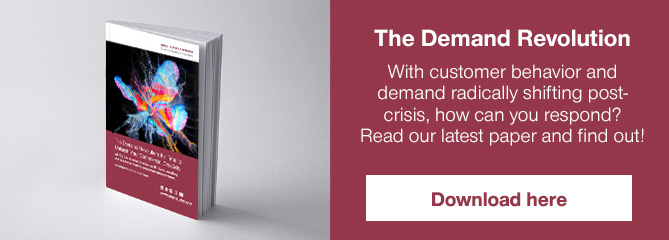Mass digital migration is leaving permanent changes in its wake. We interview Conrad Heider, Global Head of our Digital practice, to discuss how companies can respond. He tells us how some businesses have used digital to become superstars during this crisis and shares advice for shifting the digital mindset toward revenue and value creation. Read the interview here!
Conrad, many businesses have celebrated the efficiency of “remote” and have learned a great deal during 2020 about the cost benefits of digitalization. But mass digital migration has also created many top-line opportunities. Can you tell us about some of the digital trends that are creating room for companies to grow right now?
Ecommerce, ecommerce, ecommerce. That is the trend right now.
Let’s be clear: Ecommerce is not something new. However, what the pandemic has shown us is that it is going to be the most relevant channel of all. In 2020, retail ecommerce sales worldwide amounted to 4.28 trillion US dollars and e-retail revenues are projected to grow to 5.4 trillion US dollars in 2022. There is no denying that ecommerce has become pivotal for the vast majority of companies.
However, this trend also comes with a dash of anti-ecommerce. There are some customers who dislike and will possibly even abstain from this channel. They’re breaking free from the big internet companies and giving back to their community, favoring local stores over the e-giants like Amazon. This shows how shifting the channel will not automatically do a good job for every company. For some, the future of sales will lie in machine+human interaction. Others will differentiate more strongly between large key accounts and the long tail. Companies need to carefully monitor the impact, observe how customers respond, and then react to fulfill any unmet needs.
Another major trend is heightened community awareness surrounding data privacy. Here companies need to get especially creative if they are planning to grow going forward.
When the crisis struck, we were entering the biggest data creation era of all time. Companies were able to track and analyze customers’ previous behavior and predict their needs and demands for the future. Other companies built entire business models around consumer data, either selling personal information to third-parties or using data to create targeted ads. Then, in 2020, predictive tools suddenly became unreliable as historical data is of little use when faced with the unprecedented. This means companies need to find other quick and reliable means to gather customer insights.
So why now, just when we might need that extra bit of light in the dark, are companies taking a step back from cookies and personalized data tracking, like Apple, which recently killed the third-party cookie on its devices?
You just have to look at some of the discussions around corona tracking apps to see how data-conscious societies have become. We have been forced to do absolutely everything and anything online, raising the question of how much we are actually willing to share. This presents a tough challenge for companies and their advanced analytics teams who will no longer be able to use data to the extent they expected. We might never have the same level of personalized data again.
So without all the data, how can companies look forward and strategically plan? Especially if their products and services are no longer viable in the post-COVID-19 world?
You need to get much, much closer to your direct customers: first-party cookies, real interaction, feedback, and engagement.
Think about companies with proven commercial creativity muscles, like Airbnb. When the company first launched in 2008, they had no previous customers and no data. But this meant they were perfectly equipped to just react. It was part of their commercially creative DNA.
This DNA enabled Airbnb to reinvent its business at lightning speed during the pandemic. When they could no longer sell their original product due to travel restrictions, they pivoted toward becoming an events platform. Previous hosts were encouraged to offer online events for things like cooking and gaming, etc. They used the same infrastructure and oriented toward meeting this new need – entertaining, being engaged, and connecting socially – for a very similar price.
Airbnb was also built on agility. It’s how they're organized. In order to pivot a business at such great speed, you need to be cross-functional by nature, working in agile operating models. Here, end-to-end teams of eight to ten people inherit all functional credibility and responsibility, and are empowered to drive an impact. You'll find similar operating models in most unicorns and the last decade’s fastest-growing companies, which are not organized by function, but around experiences or the customer journey. Responsibility is entrenched in smaller teams, with less middle management and a fast, scale-and-learn culture.
Do you have any other examples of commercially creative companies during the crisis?
Let’s look at the long-established company Henkel, which recently opened a new innovation hub in Berlin – in fact, it’s just a stone’s throw away from our Simon-Kucher office here in the city. Henkel wasn’t born with the same DNA as Airbnb, but they are fantastic at bringing products to retail and have been pushing hard with commercial creativity during the last 12 months. They’ve been really fast to adapt and are making sustainable moves for their next wave of business.
Then, over in Asia there is JD.com – a fortune 500 company and China’s largest retailer. Why is it interesting? Similar to Airbnb, JD also pivoted toward online events, while taking the opportunity to drive alcohol sales…
You’ve talked about how Airbnb, Henkel, and JD were able to rapidly reinvent their products and go-to-market approach. But what about reinventing the revenue model? Is this something you recommend from a digital perspective?
Yes, find new ways to adapt your revenue model. But don’t simply make the switch without thinking it through…
We speak to a lot of companies that want to transfer, for example, to a subscription model. They recognize that customers don't necessarily want to own anymore and they see the success of these models in industries across B2C. But will the same be true for every category? Customers sign up for subscriptions for the constant value, usually linked to some sort of emotional connection. Turning every part of the business into a subscription without connecting to an essential experience or value probably won’t work.
There are other ways to think about the revenue model, especially in a B2B context. Just imagine, in a world filled with such high levels of uncertainty, how your customers would react if you could alleviate some of that gamble. What kind of competitive advantage would you have if you could allow customers to pay per outcome, rather than in one lump sum? Naturally, this means you as a supplier would take on a large proportion of that risk. But it’s super valuable for a customer that isn’t ready to make a major investment when they don’t know what the future holds.
Pay-per-outcome models change the whole value relationship, but for this you need the infrastructure e.g. data tracking, billing systems, ERP system, CRM etc. To charge by outcome, you need to be able to measure the outcome and therefore the only way these models will ever be feasible is through data. Digital is the crucial enabler.
Finally, what advice do you have for companies in keeping up with today’s transformation? What could a digital growth project with Simon-Kucher look like?
In all honesty, there is no silver bullet for the transformation path companies have to take. It depends on where the company stands, where their market is headed, which capabilities they have, etc. For instance, if a company needs to push strongly into ecommerce, we know the technology is available – it has been available for more than two decades. Your company can buy it, but then it becomes a question of whether the business has the capabilities to work on this on its own. It might be that an entirely new team is then needed, with different skills, a new mindset, different goals and KPIs. It might even have to rest outside of the organization – and require a separate space!
That is just one example of the directions that a digital growth project can go. In most cases, the first step is simply the realization that the transformation will drive evolution beyond the core organization. The key is to create spaces where agility can be exploited and tested.
How can your business use digital to reconnect with customers and create greater value for them? Reach out to Conrad Heider today to discuss growth opportunities!









